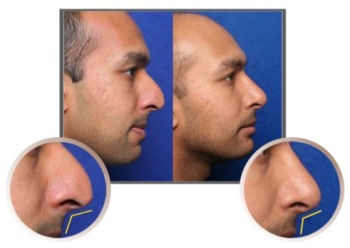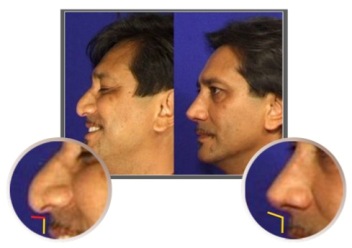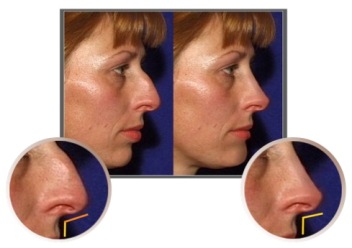A SPECIALIZATION IN NASAL HUMP REMOVALS
The Nose Clinic specializes in nasal hump removal procedures. It’s a common and popular procedure, usually done through the nostrils. And while in its simplest form it’s a relatively simple operation, it’s the most rewarding of all the rhinoplasty procedures we perform at the Nose Clinic. It’s the one plastic surgery operation that changes the lives of our patients the most profoundly. We’ve seen patients undergo an almost instantaneous psychological transformation from the moment they first see themselves after surgery. “You see it in their eyes, a great, radiant joy,” Dr Swanepoel explains. “You can’t put a price on it.”
CLOSED APPROACH
Most nasal hump removals can be done with the ‘closed’ intra-nasal approach to surgery. The closed approach usually takes about 90 minutes and if done under a conscious sedation anesthetic procedure, and not gaseous general anesthesia, it is not invasive. Swelling and bruising usually subsides within the first three to five days, and by the seventh day, when the patient visits us for the last post-operative check, the nose has settled comfortably into its new shape, ready to face the world.
COMPREHENSIVE ASSESSMENT
We base our nasal hump removal procedure on techniques that we’ve refined, simplified, and optimized over many years. We start with an expert assessment of your nose by Dr Pieter Swanepoel. He will examine the shape of your nose, the internal air channels, cartilage resilience, and the texture of your skin (a thick, sebaceous skin tends to mask or hide the results of cosmetic surgery, so we might sometimes advise patients not to undergo surgery – a result masked by thick skin would not warrant the cost of the operation).
BEFORE AND AFTER SIMULATIONS
After the assessment, Dr Swanepoel takes a series of full color images of your face to produce a life-like computer simulated preview of the proposed result. We warn patients however that the preview is a simulation, and that the actual result may differ in minor ways depending on how the tissue heals after surgery.
We give one copy of the preview to you and keep one for your medical file. Our surgeon adopts the expert assessment to plan surgery, using the simulated image as a reference to ensure a good result.
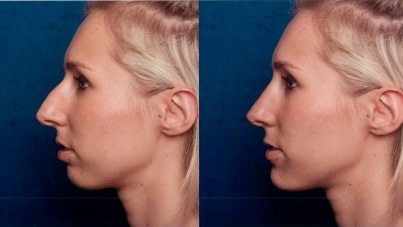
A SIMULATED PREVIEW OF THE PROPOSED RESULT. During the pre-operative consultation we create a simulated preview of the proposed result. On the left, the patient’s nose and chin as presented during the pre-operative consultation. On the right, the simulated preview of the proposed result which includes a chin augmentation.
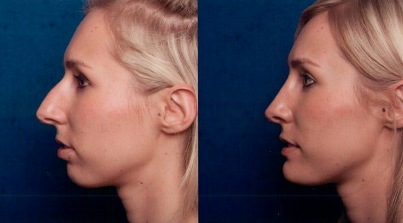
RHINOPLASTY SURGERY – ACTUAL RESULT. After surgery we take a set of before and after images. On the left, the patient’s nose and chin as presented during the pre-operative consultation. On the right, the actual post-operative result, including an augmentation of the chin.
CONSCIOUS SEDATION
Surgery starts with the preparation. We use conscious sedation – a procedure pioneered by Dr Swanepoel and his team in the mid-90’s — to lower the patient into a restful, relaxed state (most patients doze during the procedure). A specialist anesthetist introduces an intravenous anesthetic administered with a pain-killing agent and a mild sedative. The surgeon then proceeds with regional nerve blocking – a painkiller administered in tiny injectable doses — to the trigeminal nerve network located around the operative area of the nose. You won’t, in this light sedated state, feel any pain or remember the procedure afterwards.
SURGERY
The surgeon commences surgery through the nostrils – the intra-nasal approach – with a small incision just beyond the rim of the nostril on the inside of the air channel. Working through the incision he accesses the tissue/bone formations that form the foundation of the hump. Proceeding gently and sparingly with the tissue to minimize postoperative bruising and bleeding, he trims just enough tissue (and bone) to give the dorsum, or bridge of the nose, an attractive profile; not too much, not too little. Mere millimeters make a difference. This trimming lays the foundation for an aesthetically pleasing and well-proportioned profile.
Ending surgery, he inserts tiny sutures to close the incision. Next, he braces your nose with a light skin-colored splint. By this time the anesthetist has tapered off the intravenous sedation, and you’re fully awake. An hour or so later, you’re on your way to recovery in the comfort of your home. You can, at your discretion resume most daily activities within a day or two of surgery. Apart from several post-operative checkups, you’re now very close to the point where you can re-enter the world with a new, and fresh view of yourself. It is a life changing operation.
IDENTIFYING A HUMP
A drooping nose tip may create an illusion of a hump. When we encounter a drooping nose the surgeon dispenses with the usual hump removal procedure. He performs a simple ‘tip projection and rotation’ to lift the tip of the nose into natural alignment with the dorsum (bridge) and the chin.
Generally, humps usually fall into one of three possible categories — a ‘True,’ a ‘Pseudo’ or a ‘Concealed’ hump. You don’t need hump removal surgery to resolve a ‘pseudo’ (fake) hump. The surgeon will flatten the perceived hump simply by rotating the tip of your nose upward to improve and redefine the tip projection.
A ‘Concealed’ hump requires similar treatment. By lifting the tip we reduce the prominence of the hump. Both require the ‘open approach,’ a technique for accessing the underlying cartilage at the tip of the nose. We most often work with ‘true’ humps and therefor use the closed intra-nasal approach most frequently.
SEVERE HUMPS
The removal of a radical or severe hump could, to degree, restrict your breathing. Why? The process of trimming the hump to produce a pleasing profile may also reduce and narrow the nasal passage in the ‘mid-vault’ of the nose (the internal nasal valve). The traditional remedy requires the surgeon to re-widen the air passage by placing a spreader graft (a wedge) made from the patient’s septal cartilage (the dividing wall of the nose) in the apex of the now narrowed nasal passage. This ‘wedge’ restores the passage to its former width. At the Nose Clinic however, we use an optimized technique devised by Dr Pieter Swanepoel early in 2006, when he made a spreader graft from the naturally occurring upper lateral cartilages on either side of the patient’s dorsum. Because the upper lateral cartilages lie next the apex of the nasal passage where the surgeon would normally insert the spreader graft, it is a near perfect solution.
MENTOPLASTY
If, apart from the hump removal, a patient has a receding chin, we also suggest, and usually perform a chin augmentation to balance the profile. The surgeon inserts a pre-molded soft silicone chin implant through a small incision on the inside of the mouth. It’s relatively simple and produces very pleasing results.


